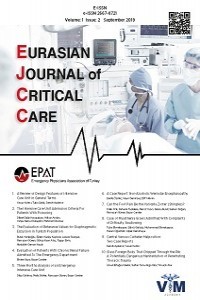Neutrophil-Lymphocyte Ratio as a Mortality Predictive Paramater In Patıents Wıth Out-of-Hospital Cardiac Arrest
Neutrophil-Lymphocyte Ratio as a Mortality Predictive Paramater In Patıents Wıth Out-of-Hospital Cardiac Arrest
emregency, NLR, resuscitation,
___
- [1]- Kim J., Kim K., Lee JH., Jo YH, Rhee JE, Kim TY et al. Red blood cell distribution width as an independent predictor of all-cause mortality in out of hospital cardiac arrest. Resuscitation 2012;83: 1248–52
- [2]-Szymanski F.M., Karpinski G., Filipiak K.J., Platek A.E., Hrynkiewicz-Szymanska A., Kotkowski M., et al. Usefulness of the D-Dimer Concentration as a Predictor of Mortality in Patients With Out-of-Hospital Cardiac Arrest. Am J Cardiol 2013;112:467-71
- [3]- Kilgannon JH, Roberts BW, Reihl LR, Chansky ME, Jones AE, Dellinger RP et al. Early arterial hypotension is common in the post-cardiac arrest syndrome and associated with increased in-hospital mortality. Resuscitation 2008;79:410–6,
- [4]- Nolan JP, Neumar RW, Adrie C, Aibiki M, Berg RA, Böttiger BW, et al. Post-cardiac arrest syndrome: epidemiology, pathophysiology, treatment, and prognostication. A ScientificStatement from the International Liaison Committee on Resuscitation; theAmerican Heart Association Emergency Cardiovascular Care Committee;the Council on Cardiovascular Surgery and Anesthesia; the Council onCardiopulmonary, Perioperative, and Critical Care; the Council on Clin-ical Cardiology; the Council on Stroke. Resuscitation 2008;79:350–79,
- [5]- Peberdy MA, Callaway CW, Neumar RW, Geocadin RG, Zimmerman JL, Donnino M, et al. Part 9: post-cardiac arrest care:2010 American Heart Association Guidelines for Cardiopulmonary Resuscitation and Emergency Cardiovascular Care. Circulation 2010;122:S768-S786
- [6]- Galus MA, Stern J. Extreme lymphocytopenia associated with toxic shock syndrome. J Intern Med 1998;244:351-54
- [7]- Jılma B., Blann A., Pernerstorfer T, Stohlawetz P, Eichler HG, Vondrovec B, et al. Regülation of adhesion molecules during human endotoxemia. Amer J Resp Crit Care Med. 1999;159:857-863
- [8]- Zahorec. Ratio neutrophil to lymphocyte counts-rapid and simple parameter of systemic inflamtion and stres in critically ill. Bratisl Lek Listy 2001;102:5-14
- [9]- Tamhane UU, Aneja S, Montgomery D, Rogers EK, Eagle KA, Gurm HS. Association between admission neutrophil to lymphocyte ratio and outcomes in patients with acute coronary syndrome. Am J Cardiol 2008;102:653-7
- [10]-Azab B, Zaher M, Weiserbs K, Estelle T. Usefulness of neutrophil to lymphocyte ratio in predicting short and long term mortality after Non-ST elevation myocardial infarction. Am J Cardiol 2010;106:470-6
- [11]- Uthamalingam S, Patvardhan EA, Subramanian S Ahmed W, Martin W, Daley M, et al. Utility of the neutrophil to lymphocyte ratio in predicting long-term outcomes in acute decompensated heart failure. Am J Cardiol 2011;107:433-8
- [12]- Kayrak M, Erdoğan Hİ, Solak Y, Akilli H, Gül EE, Yildirim O et al. Prognostic value of neutrophil to lymphocyte ratio in patients with acute pulmonary embolism: A redrospective Study. Heart, Lung and Circulation 2014;23:56-62
- [13]-Conquy MA, Cavaillon JM. Compensatory anti-inflammatory response syndrome. Thromb Haemost 2009; 101: 36–47 [14]-Biswas SK, Lopez-Collazo E. Endotoxin tolerance: new mechanisms, molecules and clinical significance. Trends in Immunology 2009;30: 475-87
- [15]-Bone RC, Grodzin CJ, Balk RA. A New Hypothesis for Pathogenesis of the Disease Process. Chest 1997; 112:235-43
- [16]-Cavaillon JM, Adrie C, Fitting C, Conquy MA. Endotoxin tolerance: is there a clinical relevance? J Endotoxin Res 2003;9:101-7
- [17]-Adrie C, Adib-Conquy M, Laurent I, Monchi M, Vinsonneau C, Fitting C, et al. Successful cardiopulmonary resuscitation after cardiac arrest as a ‘‘sepsis-like’’ syndrome. Circulation 2002;106:562—8.
- [18]-Adrie C, Laurent I, Monchi M, Cariou A, Dhainaou JF, Spaulding C. Postresuscitation disease after cardiac arrest: a sepsis-like syndrome? Curr Opin Crit Care 2004;10:208-12.
- [19]-Sauneufa B, Bouffarda C, Cornet E, Daubin C, Desmeulles I, Masson R et al. Communication Immature/total granulocyte ratio: A promising tool to assess theseverity and the outcome of post-cardiac arrest syndrome. Resuscitation. 2014 ;85:1115-9
- [20]-Stub D, Bernard S, Duffy SJ, Kaye DM. Post Cardiac Arrest Syndrome: A Review of Therapeutic Strategies Circulation 2011;123:1428-1435 [21]-Vasileiou PVS, Xanthos T, Barouxis D, Pantazopoulos C, Papalois AE, Lelovas P et al. Erythropoietin administration facilitates return of spontaneous circulation and improves survival in a pig model of cardiac arrest. Am J Emerg Med. 2014;32:871-7
- [22]-Dell’anna AM, Vinotti JB, Beumier M, Orbegozo-Cortes D, Donadello K, Scolletta S et al. C-reactive protein levels after cardiac arrest in patients treated with therapeutic hypothermia. Resuscitation. 2014 ;85:932-8.
- [23]-Annborna M, Dankiewicza J, Erlinge D, Hertel S, Rundgren M, Smith JG, et al. Procalcitonin after cardiac arrest – An indicator of severity of illness, ischemia-reperfusion injury and outcome. Resuscitation 2013;84:782–87.
- Başlangıç: 2019
- Yayıncı: Acil Tıp Uzmanları Derneği
A Case Of The Surviving From Gunshot Injury Without Operation
Merve DEMİRELLER, Oya GÜVEN, Özlem TATAROĞLU
Mine ALTINKAYA ÇAVUŞ, Hafize SAV
Role of Radiology in Pica Syndrome: A Case Report
Does Passive Leg Raising Affect Intracranial Pressure in Healthy Volunteers?
Emre GÖKÇEN, Dilek ATİK, İbrahim ÇALTEKİN, Levent ALBAYRAK, Atakan SAVRUN, Sevilay VURAL, Şeyda Tuba SAVRUN
Evaluation Of The Awareness Of Chronic Kidney Disease Among Patients Receiving Hemodialysis
Mehmet Yilmaz SALMAN, İnan UTKU, Fatih KURTULUS
L-Carnitine treatment in a child with valproic acid intoxication
Mehmet Özgür ARSLANOĞLU, Ebru KAÇMAZ, Gürkan BOZAN, Ener Cagri DINLEYICI, Burak ÖZKAN, Sabiha SAHİN
Hilal SİPAHİOĞLU, Aliye ESMAOĞLU ÇORUH, Ali SARI, Kürşat GÜNDOĞAN, Murat SUNGUR
Evaluation of tracheatomies performed by percutaneous dilatation method in adult intensive care unit
Mine ALTINKAYA ÇAVUŞ, Şerife GÖKBULUT BEKTAŞ
Belgin AKILLI, Hüseyin MUTLU, Yahya Kemal GÜNAYDIN, Ramazan KÖYLÜ, Levent OKTAR, Basar CANDER
